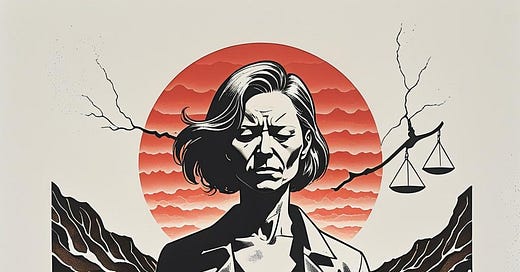Crime, Justice, and the Media’s Fascination with Demonising Female Criminals
The Case of Aileen Wuornos, victimhood and the pipeline to perpetrating
The case of Aileen Wournos captured international attention not only because of the brutality of their crimes but because she disrupted deeply engrained societal norms about femininity, violence and victimhood.
When women engage in extreme acts of violence, particularly against women, it challenges dominant gender expectations, provoking intense media scrutiny and public fascination. These reactions are rarely neutral; instead, female offenders are often sensationalised, pathologised or cast as monstrous exceptions to womanhood.
Through Wuornos, we see how media narratives and justice system responses are shaped by a collective discomfort with female violence. These women become more than perpetrators — they become symbols onto which society projects its anxieties about gender, power, and morality. As such, their stories reveal how deeply gendered the cultural understanding of crime and justice truly is.
Aileen Wuornos, often labelled ‘America’s first female serial killer’, murdered seven men in Florida between 1989 and 1990, whom she shot dead and robbed. She was sentenced to death and executed on October 9, 2002, by lethal injection.
Wuornos was a sex worker with a history of abuse, homelessness and mental illness. She claimed that these man had attempted or had raped her and the homicides of the men were committed in self-defence.
However, the narrative of these crimes were heavily dismissed and overlooked. The media instead leaned into a narrative of Wuornos as a man-hating predator and the embodiment of female rage and moral corruption.
Documentaries (The Selling of a Serial Killer, Life and Death of a Serial Killer) and the Hollywood film Monster (2003) portrayed Wuornos as both a tragic figure and a terrifying one. This media emphasised her aggression and emotional volatility and perceived lack of femininity. Rather than being humanised throughout her trauma she was pathologised.
Her courtroom outbursts and erratic behaviour were framed not as signs of mental deterioration, but as evidence of her evil. The media’s obsession with her background as a sex worker and her lesbian relationship also fed into voyeuristic curiosity and moral judgment.
Between the ages of fourteen and twenty-two, she had tried to attempt suicide more than six times.
Wuornos had an upsetting childhood and upbringing. Her mother was fourteen when she married Wuornos’ father and was sixteen when she gave birth to her and her brother. Her father had a history of kidnapping and raping a child and was also diagnosed with schizophrenia. He committed suicide in prison in 1969.
When she was four years old, her mother abandoned her and her brother, leaving them with alcoholic grandparents who sexually assaulted Wuornos by the time she was eleven years old. By then she was engaging in sexual activities with her brother and other classmates in exchange for drugs, cigarettes and food. By fourteen, she was pregnant and had dropped out of school after being raped. The baby was placed for adoption whilst she stayed at a home for unwed mothers. When she was fifteen, she was kicked out of her home and began living in the woods and supporting herself through prostitution.
Throughout her younger years she was being arrested for numerous counts of disorderly conduct, assaults, DUIs, armed robberies, car theft, failure to appear and obstruction of justice and resistance to arrest.
Between December 1989 and November 1990, Wuornos had killed seven men in Florida, many found shot dead along highways.
Wuornos was arrested in January 1991 after police used her close companion, Tyria Moore, to gain a confession. Moore, whom Wuornos had lived with in a romantic relationship, agreed to cooperate with investigators in exchange for immunity. Police recorded their phone calls, during which Moore persuaded Wuornos to confess to protect her. Wuornos eventually admitted to the killings.
The court case began in 1992, and she was tried first for the murder of Richard Mallory, a convicted rapist whose prior history was not disclosed during the trial. The prosecution painted Wuornos as a calculated serial killer who murdered for financial gain. Her defense claimed she acted in self-defense, but the jury was unconvinced.
She was found guilty and sentenced to death. She later pleaded no contest to several other murders and received additional death sentences. Wuornos was eventually sentenced to death six times.
Her version of events drew attention to the risk faced by women in the sex trade and raised questions about victimhood and agency. owever, her explanation was met with skepticism, especially because some victims had no known criminal history or evidence of sexual assault. Wuornos later recanted and reasserted her self-defense claims multiple times, contributing to confusion and media speculation.
The media played a major role in shaping public perception of Wuornos. She was often portrayed as a “man-hating lesbian prostitute” and “monster,” reinforcing damaging stereotypes about violent women. Her gender and sexuality became key features in the media spectacle that surrounded her case.
Her execution and the circumstances surrounding her case continue to provoke debate about the death penalty, justice for women with traumatic pasts, and how poverty, abuse, and marginalisation intersect with violent crime. Her life remains a powerful — and painful — case study in how society treats women who commit violence outside the bounds of socially accepted narratives.
When women commit violent crimes, especially against other women or in contexts that defy expected gender roles, the media tends to amplify and distort their stories. Her background—marked by poverty, sexual abuse, and sex work—was not simply reported but sensationalised, reinforcing stereotypes about violent women as deviant and outside the bounds of acceptable femininity. This coverage often overshadowed any nuanced discussion of her trauma or the systemic issues that shaped her life.
The media and justice system often pathologize violent women, framing their actions as the result of mental illness, emotional instability, or biological drives rather than as autonomous choices or responses to external pressures. Wuornos’s courtroom outbursts and erratic behavior were interpreted as signs of inherent evil rather than possible symptoms of mental distress or trauma.
The debate over how we demonise women who commit violence is ongoing. Critics argue that the media and justice system’s approach to cases like Wuornos’s reflects and reinforces gender inequality, perpetuaring harmful stereotypes and legitimising harsh punishments for women who challenge traditional roles.
The demonization of women like Aileen Wuornos reveals deep-seated anxieties about female agency, sexuality, and violence. Their stories are shaped by media and cultural narratives that seek to reinforce traditional gender norms, often at the expense of understanding the complex realities of their lives.
Several other women in history and pop culture have become notorious for acts of violence and their portrayals reflected in the same patterns of sensationalism, demonisation and symbolic projection as seen in the case of Aileen Wuornos. The pipeline from victimhood to perpetration is a complex and sensitive subject, often explored in criminology and psychology but rarely addressed straightforwardly in popular narratives.
Many female offenders experience severe childhood trauma such as physical abuse, sexual abuse, neglect and abandonment. Women who become perpetrators face poverty, homelessness and lack of access to education and support systems.
The experience of being a victim can sometimes normalise violence or lead to learned patterns of aggression, especially if the individual has no positive role models or support networks.
And society and pop culture’s response? Sensationalise and demonise female perpetrators and focus on their appearance, their acts of violence and overlook the systemic and traumatic issues that shaped their behaviour.
Women who act in self-defence or are manipulated into believing their violent actions are justified are important examples of how victimisation and coercion can contribute to women’s involvement in violence. These cases challenge the simple narrative of “victim vs. perpetrator” and highlight the complex realities many women face.
The legal doctrine of self-defense often requires that the woman reasonably feared imminent harm at the time of the act. However, this standard can be difficult for women to meet, especially if the violence is chronic and the threat is not immediate at the moment of the killing.
The narrative is flawed. Women are either pure victims or irredeemable monsters.
The pipeline from victimhood to perpetration is rarely explored in depth in mainstream media or public discourse. When it is addressed, it is often to pathologise the individual rather than to critique the social and systemic factors that contribute to the cycle of violence





